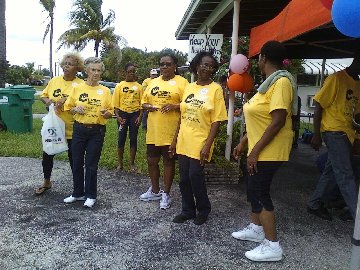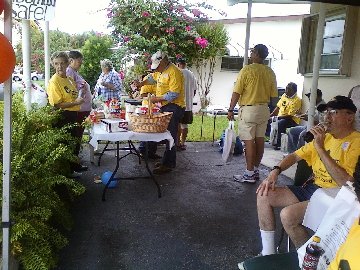Crime Watch Revitalization: Igniting the Spark
Veteran crime watch leaders find creative new ways to encourage member participation and serve the community.
 Photos credited to Citizens' Crime Watch of Miami-Dade County
Photos credited to Citizens' Crime Watch of Miami-Dade County
Trivia buffs will be delighted to learn that January, the first month in the Julian and Gregorian calendars, was named after Janus, ancient Roman god of the doorway. Traditionally, this “entrance to the new year” is a time for personal reflection and for making new resolutions (perhaps to hit the gym more often in hopes of shedding those stubborn Turkey Day pounds!) For crime prevention organizations, the start of the New Year is also an opportune time to review past achievements, identify present deficiencies, and re-affirm commitment to future success.
In many well-established crime watch communities, complacency and apathy—not drug dealers or petty thieves—are the greatest threats to neighborhood safety and security. Neighborhood Watch leaders often find that once the specific crime issues that initially united the group are resolved, involvement wanes. Criminals may take advantage of this false sense of security, leading to a new spike in illegal activity.
Maintaining the community’s interest and encouraging long-term participation in Neighborhood Watch is challenging but well worth the effort (and infinitely more enjoyable than those hours spent on the Stairmaster!) Put to good use, creative thinking and effective communication skills are the crime prevention leader’s most valuable tools for bolstering and sustaining member dedication and support.
Problem Solved…. Or is it?
One February evening in 2006, residents of Ives Estates, a normally quiet suburb of North Miami, were startled by the sounds of gunfire. “My family and I were watching TV, when all of a sudden we heard shots and hit the floor,” recounted Reverend Henry Moss. The shooting was the latest in a series of crimes, which included robberies at a nearby plaza and a spike in drug activity, and the last straw for Moss. “I said ‘enough is enough’ and began knocking on doors. I found people who were very interested in crime watch, and we got involved with the local police department and Citizens’ Crime Watch of Miami-Dade County.”
Five years later, the Ives Estates Crime Watch comprises three groups—the Northeast 15th Avenue Crime Watch, 12th Avenue Crime Watch, and 203rd Court Crime Watch. No more shootings have occurred since the groups were formed, and both home and commercial burglaries have declined sharply. Among other triumphs, Ives Estates Crime Watch members have helped local law enforcement to identify youth selling drugs from an abandoned neighborhood residence. Following the perpetrators’ arrest, the home was sold and the new owners have joined Crime Watch. The Northeast 15th Avenue Crime Watch also has worked with Miami-Dade County Police and Team Metro to address a homelessness problem and to install a speed trailer to encourage motorists to slow down.
A Perfect Fit: Something for Everyone
Unlike some crime prevention organizations, the Ives Estates Crime Watch maintains a very active, dynamic member base, despite having resolved its most serious crime issues. According to Moss, now the organization’s chairman, the secret to success is diversification. “We’re not just a crime watch. We focus on community projects.” Such special projects are a great way to rekindle crime watch participants’ interest, he believes. “If members are getting bored but have already done training, I recommend they consider taking on a community project that’s based on the group’s interest.” Civic organizations, charities, and nonprofits usually are eager to welcome volunteers, who might assist with everything from fundraising to community cleanup events. In Ives Estates, group activities now include hosting a Thanksgiving food drive and collecting food, clothing, and toys for a needy family at Christmas. The group’s newest project involves providing personal items such as music CDs for children and young adults who reside in a local group home.
Community safety events also provide an opportunity for watch members to share crime prevention and personal safety training tips and experience. From October 2010 to September 2011, members of the Citizens’ Crime Watch of Miami-Dade County, the area’s largest watch organization, took part in dozens of activities, including bicycle rodeos, health fairs, National Night Out and Celebrate Safe Communities events, and a Miami-Dade Police District open house. During the same period, volunteers from the group’s Youth Crime Watch participated in county public library safety programs, bullying prevention campaigns, and other events targeted at young people.
Another natural offshoot for many watch groups is disaster preparedness. Crime prevention training prepares volunteers to recognize and assess potential emergency situations, quickly alert the proper authorities, and assist neighbors in need. Such skills are particularly valuable on the oft-battered Florida Coast, where most hurricanes making landfall in the United States hit. “Our Crime Watch groups that have stayed proactive got together after Hurricane Wilma. They knew which neighbors were elderly and who used wheelchairs or needed special assistance,” said Carmen Caldwell, executive director of the Citizens’ Crime Watch of Miami-Dade County, who noted that the group has also participated in County Commission Chairman Joe Martinez’s Annual Health, Safety & Hurricane Readiness Expo and in Citizen Corps safety events.
Home Economics
The global recession and ongoing financial crisis have negatively impacted communities nationwide, and the resulting economic instability has led to budget cuts in all sectors, law enforcement and public services included. In the Greater Miami area, like in other cities, deterioration and blight are now the number-one problems affecting the crime watch community. “When the economic crisis started, we had abandoned houses, which led to an increase in burglaries, copper theft, squatting, and grow houses,” Caldwell said. “Fortunately, we have ordinances in place requiring property owners to correct these issues by a certain deadline.”
During these austere times, belt-tightening has stretched most law enforcement agencies’ service capacity. “Many areas have had budget cuts to their crime prevention programs,” making Neighborhood Watch even more important than ever,” Caldwell said. Therefore, another important component is cooperation between Neighborhood Watch groups and their elected officials. “We work on quality of life and crime prevention issues with the county commissioner and board officials, many of whom are close to the neighborhoods.”
Coming in Loud and Clear
No special interest projects alone can galvanize crime watch membership in the absence of good communications. Neighbors getting acquainted with each other and with their local law enforcement leaders are at the heart of the Neighborhood Watch concept. Meeting regularly, bi-annually or monthly, is a good way to foster these relationships as well as hone crime prevention skills learned during training.
The Citizens’ Crime Watch of Miami-Dade County requires member groups to meet periodically in order to receive Neighborhood Watch signage. Groups also must create a phone chain that lists member home and work numbers, email addresses, as well as names of and information about their local elected officials. “Meetings are a good opportunity for members to update their contact information and stay in touch,” Caldwell said. “Most of our groups meet at least two times a year or more often if an issue arises.” However, she stresses, “Even without meetings, Neighborhood Watch groups should maintain relationships with law enforcement and their neighborhood resources officers.”
Written communications such as newsletters and online blogs also are excellent venues for sharing important news, crime trends, and highlights with neighbors, law enforcement liaisons, and local officials. Enlisting volunteer “beat reporters” from within the group to write a monthly newsletter column on issues such as vacation safety or provide regular neighborhood news updates is a good way to keep members actively engaged. The best vehicle for keeping members in the know varies by watch group. While technophiles might be content with daily “tweets,” busy executives might prefer a weekly email update. Also, Caldwell reminds groups not to overlook the most basic of Neighborhood Watch tools, the telephone chain, especially in communities with few or infrequent computer users or in areas where high-speed Internet services are unavailable.
With the Citizens’ Crime Watch of Miami-Dade County having established 344 new watches and revitalized 215 existing groups, Caldwell has personally seen the consequences of inactivity. “We do a lot of reactivation when signs are stolen or a new crime is committed.” However, she says, “Putting signs up won’t stop crime. If you don’t call the police and stay active by being aware of what is happening in your neighborhood, crime will return. Bottom line, it is up to the residents on the block to make Neighborhood Watch happen.”
Credit Where Credit Is Due
Neighborhood Watch volunteers give generously of their time and talent with no expectation of compensation. Nonetheless, everyone, even the most unassuming member, needs to feel appreciated. The Neighborhood Watch Manual recommends that groups periodically take time to recognize their members. Formal events might include a special dinner and/or award ceremony, or even a laudatory member profile in the group newsletter. Informal opportunities for recognition also abound and include such simple gestures as a heartfelt thank you note or a gift certificate as a reward for special service.
Neighborhood Watch volunteers come from diverse professional backgrounds and seldom view membership as a means of climbing the corporate ladder. Regardless, most individuals, from high schoolers to retirees, appreciate the opportunity to learn new skills and take on new responsibilities within the organization.
Eye Toward the Future
 Here in America, we often take a “checklist” approach to problem-solving—identify the problem, tackle it, cross it off the list, and move forward. While this method fosters progress, it is doomed to failure if we forget to monitor and nurture the relationships we work so hard to forge. As the Neighborhood Watch concept continues to evolve from traditional crime prevention to encompass issues ranging from quality of life to domestic terrorism, the role each volunteer plays becomes more critical to group success.
Here in America, we often take a “checklist” approach to problem-solving—identify the problem, tackle it, cross it off the list, and move forward. While this method fosters progress, it is doomed to failure if we forget to monitor and nurture the relationships we work so hard to forge. As the Neighborhood Watch concept continues to evolve from traditional crime prevention to encompass issues ranging from quality of life to domestic terrorism, the role each volunteer plays becomes more critical to group success.



